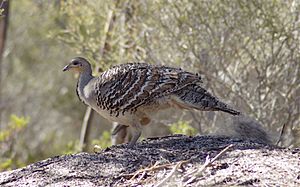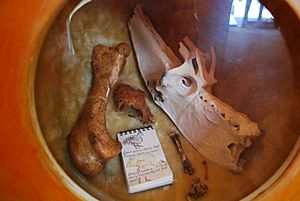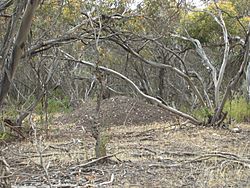Malleefowl facts for kids
Quick facts for kids Malleefowl |
|
|---|---|
 |
|
| In Ongerup, Western Australia | |
| Conservation status | |
| Scientific classification | |
| Genus: |
Leipoa
|
| Species: |
ocellata
|
The malleefowl (Leipoa ocellata) is a special Australian bird. It lives on the ground and is about the size of a chicken. Malleefowl are famous because the male birds build huge nests on the ground. They also don't take care of their babies after they hatch. The malleefowl is the only living bird in its group, called Leipoa. A very large bird called the giant malleefowl used to be a close relative, but it is now extinct.
Contents
Malleefowl Behaviour
Malleefowl are shy and careful birds. They usually live alone. They only fly if they are in danger or need to get to a tree to sleep. Even though they are very active, people rarely see them. This is because they freeze and stay still if something bothers them. Their feathers have a complex pattern that helps them blend in. They can also quietly and quickly disappear into the bushes. They only fly away if they are surprised or chased. These birds have many ways to escape from predators.
Malleefowl Reproduction and Life Cycle
Malleefowl pairs share a territory. However, they usually sleep and find food separately. They only come together for mating during the breeding season.
In winter, the male malleefowl chooses a spot on the ground. This is usually a small, open area between the short mallee trees. He scrapes a hole about 3 metres (10 feet) wide. It is just under 1 metre (3 feet) deep in the sandy soil. He uses his feet to rake backwards.
In late winter and early spring, the male starts gathering plants. He scrapes sticks, leaves, and bark into long piles. These piles can be up to 50 metres (164 feet) long around the hole. He builds this material into a nest mound. The mound usually rises about 0.6 metres (2 feet) above the ground. The amount of plant material in the mound changes. It can be almost all plants, mostly sand, or a mix of both.
After it rains, the male turns and mixes the material. This helps it to rot and create heat. If the conditions are right, he digs an egg chamber in August. This is the last month of winter in the southern part of Australia. The female sometimes helps dig the egg chamber. The timing depends on the temperature and rainfall. The female usually lays eggs between September and February. This happens if enough rain has fallen to start the plants rotting. The male keeps taking care of the nest mound. He slowly adds more soil as summer gets closer. This helps to control the temperature inside the nest.
Males usually build their first mound when they are about four years old. They might also take over an old one. However, their nests are not as impressive as those built by older birds. Malleefowl are thought to mate for life. The males stay near the nests to protect them for nine months of the year. But they can wander away at other times. They do not always come back to the same territory.
The female lays between 2 and over 30 large eggs. Most often, she lays about 15 eggs. Each egg has a thin shell. She usually lays one egg about a week after the last one. Each egg weighs about 10% of the female's body weight. Over a whole season, she often lays eggs that weigh 250% of her own weight. The number of eggs laid changes a lot between birds and with how much rain falls. How long the eggs take to hatch depends on the temperature. It can be anywhere from about 50 to almost 100 days.

Baby malleefowl use their strong feet to break out of the egg. Then they lie on their backs and scratch their way to the surface. They struggle hard for 5 to 10 minutes to move 3 to 15 centimetres (1 to 6 inches) at a time. Then they rest for about an hour before starting again. Reaching the surface takes between 2 and 15 hours.
Chicks pop out of the nest material with little warning. Their eyes and beaks are tightly closed. They immediately take a deep breath and open their eyes. Then they freeze and stay still for up to 20 minutes. The chick then quickly comes out of the hole. It rolls or stumbles to the bottom of the mound. It disappears into the bushes in just a few moments. Within an hour, it can run quite well. It can flutter for a short distance and run very fast within two hours. Even though it does not have tail feathers yet, it can fly strongly within a day.
Young malleefowl chicks do not have contact with adult birds or other chicks. They tend to hatch one at a time. Malleefowl of any age ignore each other. They only interact for mating or when fighting over territory.
Where Malleefowl Live
Malleefowl live in dry mallee scrublands. These areas are on the edges of the fertile parts of southern Australia. They are now found in three separate groups:
- The Murray-Murrumbidgee river area.
- West of Spencer Gulf near the Simpson Desert.
- The dry edge of Western Australia's fertile southwest corner.
Important Bird Areas for Malleefowl
Several important bird areas in southern Australia are important for protecting malleefowl. These areas have been chosen by BirdLife International.
New South Wales
- Central NSW Mallee
- Goonoo
- Southern NSW Mallee
South Australia
- Gawler Ranges
- Gum Lagoon
- Peebinga
- Riverland Mallee
- Southern Yorke Peninsula
Victoria
- Little Desert
- Murray-Sunset, Hattah and Annuello
- Wandown
- Wyperfeld, Big Desert and Ngarkat
Western Australia
- Dragon Rocks
- Dunn Rock and Lake King
- Fitzgerald River
- Holleton
- Karara and Lochada
- Karroun Hill
- Lake Magenta
- Mount Gibson and Charles Darwin
Protecting Malleefowl
Across its range, the malleefowl is considered to be threatened. This means its numbers are getting smaller. One problem is red foxes, which were brought to Australia. They hunt malleefowl. But the main problems are changes in how often fires happen and the ongoing destruction of their homes. Their habitat is also being broken into smaller pieces.
Like the southern hairy-nose wombat, malleefowl are very sensitive to droughts. Droughts are happening more often and are more severe because of climate change. Before Europeans arrived, malleefowl lived in huge areas of Australia.
International Conservation Status
The malleefowl is listed as vulnerable on the International Union for Conservation of Nature Red List. This means it faces a high risk of becoming extinct in the wild.
Australian Conservation Status

Malleefowl are listed as vulnerable under Australia's Environment Protection and Biodiversity Conservation Act 1999. Their conservation status has changed over time. It also differs from state to state within Australia. For example:
- In Victoria, the malleefowl is listed as threatened under the Flora and Fauna Guarantee Act (1988). An Action Statement has been made to help this species recover and manage its future.
- On Victoria's 2007 list of threatened animals, the malleefowl is listed as endangered. This means it is in great danger of disappearing.
- In South Australia, the malleefowl is listed as vulnerable on schedule 8 of the National Parks and Wildlife Act 1972.
- In New South Wales, malleefowl are listed as endangered on the Threatened Species Conservation Act 1995.
Yongergnow Australian Malleefowl Centre
The Yongergnow Australian Malleefowl Centre is in Ongerup, Western Australia. It is on the road between Albany and Esperance. The centre opened in February 2007. Its goal is to teach people about the malleefowl and how to protect it. It has a permanent exhibit and a large aviary with a pair of malleefowl. The centre collects reports of malleefowl sightings.
Images for kids
-
Mound photographed at Wongan Hills, Western Australia in the 1900s
See also
 In Spanish: Talégalo leipoa para niños
In Spanish: Talégalo leipoa para niños





